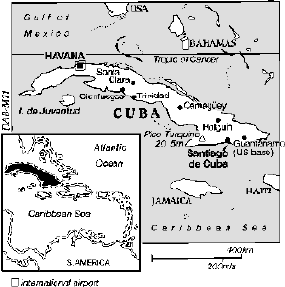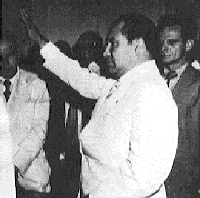|
| |

Cuba: The Decades Before Castro
(click one of the images to see an enlarged view)

A Brief Tour of Cuba
 |
Cuba is an island nation in the
northern Caribbean. At its northernmost point, Cuba is about 100 miles from the southern
tip of Florida. It stretches southeasterly 750 miles from the eastern Gulf of Mexico
through the northern Caribbean and measures fifty to eighty miles wide (it's pretty
small). The highest mountains in Cuba, located in the Sierra Maestra range in the
southeastern Oriente Province, exceed 6,000 feet. Except for three small areas, the
western lowlands range from sea level to just under 600 feet in elevation and cover 60
percent of the island.
|

This page will focus on Cuba before Castro, starting with the impact of
the Spanish-American war. The war led to the involvement of the United States in Cuban
affairs and government and the rise and fall of Cuban presidents Machado and Batista.

The Seeds of Revolution:
The Spanish-American War triggered revolutionary ideals1 in Cuba. This war left Cuba
free of Spanish colonization. The Cuban people thought that once the Spanish left, they
would be free. Instead, the United States simply took Spain's place. The U.S. occupied the
island with military force, and wanted to play a part in the formation of the new Cuban
government. The U.S. pressured Cuba to write a constitution that gave the U.S some control
over the internal affairs of Cuba.
The Platt Amendment:
In 1901, the U.S. passed the Platt amendment, listing certain conditions
that Cuba had to abide by before they would be granted independence. These conditions
included allowing the U.S. to post naval bases on the island, and to intervene in Cuban
affairs.
The Platt amendment, however, required more responsibility then the U.S. had
anticipated. In 1905, there was an armed rebellion against the presidency of Estrada
Palma. He backed out of office, forcing the United States to install a provisional
government (i.e. a military rule backed by U.S. troops to keep order). This lasted for two
years under the command of Charles Magoon, until new elections were held in 1909. America
continued to intervene, within provisions of the amendment, until it was terminated in
1934.
Machado and Batista:
In 1924 Gerardo Machado was elected as president; he was a violent dictator. He used
the military for his personal needs, which included controlling the people. In September 1933 there
was a coup2. Machado was overthrown by Fulgencio Batista. After the coup, Cuba was
ruled by several men, but Batista was the power behind them. In September 1933 there
was a coup2. Machado was overthrown by Fulgencio Batista. After the coup, Cuba was
ruled by several men, but Batista was the power behind them.
Batista became president in 1940 and was supported by the United States. Batista
started with foreign investments, and the economy started to grow; Cuba became a tourist
paradise. As the country prospered, Batista ruled more like a dictator. Batista stayed in
power for several years before retiring. However he reemerged in March 1952, and overthrew
the newly elected president, Carlos Prio. Batista suspended constitutional rights, closed
down the legislature, and banned all political parties. This was all done without any
bloodshed. However, he soon realized that the army did not support him; violent assaults
against his regime began in July 1953 -- it was Fidel Castro.
Conclusion
This brings us to a conclusion of Cuban history from about 1900 up until 1953. Every
piece of Cuban history is a building block that comes together with all the other pieces
to form Cuba's future. Each of these pieces leads up to another important section of
history that we have come to know as Castro's Revolution.
From this information, our group of researchers have drawn an opinion that the United
States policies seem inhumane and aggressive towards Cuba. We feel that it is against the
founding ideals of America, which seeks "liberty, justice, and freedom for all,"
to treat people in this manner. Cuba is a sovereign country and not a part of the United
States of America, and she should be treated with the same diplomacy as our country
demands.


Definitions:
Revolutionary ideals1- ideas of radical
change; ideas to move toward change.
Coup2--
a sudden, successful action; brilliant stroke.
Bibliography:
Cuba: places and peoples of the world By Clifford W. Crouch
Cuba: places in the news By Gail B. Stewart
Links to other Web sites:
This page was created by the Learning Community team of:
Ross Russell,Allison Shaw
and Alexandra Webb

|